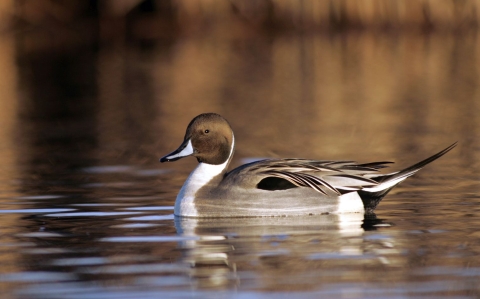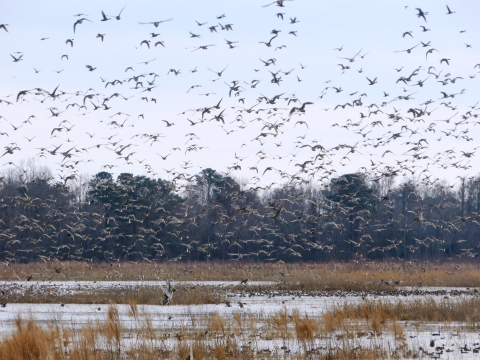The Northern Pintail (Anas acuta) is a graceful, migratory waterfowl celebrated for its striking appearance and fascinating behavior. With its sleek chocolate-brown head and distinctive long tail feathers, this elegant duck has inspired birdwatchers, photographers, and artists alike. Notably, Chuck Black's painting of a Northern Pintail won the 2023 Federal Duck Stamp Art Contest and now graces the 2024 Federal Duck Stamp, highlighting the bird’s iconic status in conservation efforts.
Conservation Status of the Northern Pintail
Northern Pintails are among the most widespread duck species globally, with populations across North America, Europe, and Asia. While their numbers remain high, habitat loss and climate change climate change
Climate change includes both global warming driven by human-induced emissions of greenhouse gases and the resulting large-scale shifts in weather patterns. Though there have been previous periods of climatic change, since the mid-20th century humans have had an unprecedented impact on Earth's climate system and caused change on a global scale.
Learn more about climate change pose ongoing challenges to their long-term survival. Protecting wetland habitats is critical to ensuring their future.
How to Identify Northern Pintails
Male Northern Pintail Features
- Size: Comparable to a crow (25–29 inches).
- Head and Neck: Chocolate-brown head with a slender neck and a white stripe running from chest to head.
- Body: Subtle grey with fine patterns, accented by black and white rump feathers.
- Tail: Long, pointed tail feathers are a defining feature.
- Bill and Feet: Blue-grey bill with black markings.
Female Northern Pintail Features
- Size: Slightly smaller, similar to a mallard (21–23 inches).
- Coloration: Mottled brown plumage, offering excellent camouflage.
- Tail: Shorter, rounded tail compared to the male's elongated version.
- Bill: Duller grey with faint patterns.
In Flight
Northern Pintails are slender, long-necked, and characterized by narrow wings. Their aerodynamic build makes them fast flyers, capable of reaching speeds up to 48 mph.
Northern Pintail Calls
- Male Calls: a two note flute-like whistle.
- Female Calls: Quacks similar to a mallard.
- Courtship Sounds: A distinctive "geeheee" followed by a whistle.
Learn more about Northern Pintail calls here.
Where to Spot Northern Pintails in December
In the Southeast U.S., Northern Pintails are commonly found in marshes, shallow ponds, and mudflats. They frequent National Wildlife Refuges during their winter migration.
Top Southeastern Wildlife Refuges for Northern Pintails
- Mattamuskeet National Wildlife Refuge (North Carolina)
Shallow lakes and impoundments provide ideal winter habitats.
- ACE Basin National Wildlife Refuge (South Carolina)
Freshwater wetlands attract large flocks of migratory pintails.
- Merritt Island National Wildlife Refuge (Florida)
This refuge is one of the most important areas for Atlantic flyway pintails. It has a wildlife drive for public viewing.
- Bald Knob National Wildlife Refuge (Arkansas)
It is one of the most important refuges in the Mississippi Flyway for migrating and wintering pintail.
- Lacassine National Wildlife Refuge (Louisiana)
Extensive marshlands at the Mississippi River delta host pintails in large numbers.The refuge has a wildlife drive and is easily accessible to the public.
5 Fun Facts About the Northern Pintail
- Northern Pintails migrate at night, reaching speeds of 48 mph. The longest recorded nonstop flight was 1,800 miles.
- The bird's name comes from its iconic long, pointed tail feathers, which can be a quarter of its body length.
- Pintails nest on the ground in open habitats like grasslands or tundra, relying on camouflaged plumage to protect their eggs.
- They are versatile travelers, spotted on every continent except Antarctica.
- Pintails feed on seeds, aquatic plants, insects, and crustaceans, adapting their diet seasonally.
Join the December Northern Pintail Photo Contest
Celebrate this month’s bird by submitting your original photos of Northern Pintails! Winners will be featured on U.S. Fish and Wildlife Service social media and included in a year-end showcase of 2024’s top bird photography.
Submission Guidelines:
- Include your name, email, and photo location in the file name.
- Winners will be contacted via email and asked to sign a photo release form.
How to Enter:
Submit your Northern Pintail photo here!
Follow our Southeast Region on Facebook and X (formerly Twitter)for contest updates and winner announcements.












